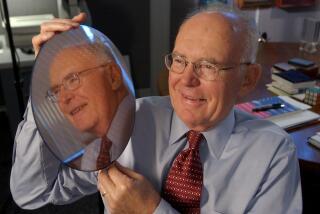Seymour Cray, Supercomputer Inventor, Dies
- Share via
Seymour Cray, a legendary engineer and entrepreneur who for more then three decades built the world’s fastest computers, died Saturday at age 71.
Cray succumbed to the severe head and neck injuries he suffered in a Sept. 22 traffic accident near his Colorado Springs home.
Widely known as the father of the supercomputer, Cray co-founded Control Data Corp. in the mid-1950s, and later launched Cray Research Inc. and then Cray Computer Inc. His name became synonymous with the super-powerful computers used in scientific research, weapons development, oil exploration and other fields, and he was considered a national treasure by the defense and scientific research establishment.
Recently, Cray seemed ready to write another chapter in his storied career, starting a fourth company, SRC Computer Inc., which took its name from Cray’s initials. As always, Cray’s mission was to build the world’s fastest computer.
“He was a giant of the 20th century. I think of him as an Edison,” Larry Smarr, director of the National Center for Supercomputing Applications at the University of Illinois at Champaign-Urbana, said Saturday.
“He was in the great tradition of American inventors, which we have very few of anymore. He was the lone genius inventor. I think the reason people considered him unusual was because he was so genuine. Seymour Cray detested hype.”
To describe that genius, friends often told the story of Cray and his sailboats. An avid sailor, Cray built a new sailboat each winter for several years.
By the middle of the summer, he would have ideas for his next boat, said John Rollwagen, former chief executive of Cray Research Inc., a company Cray started in 1976 that was sold this year to 3-D computer maker Silicon Graphics Inc.
Then, at summer’s end, the old boat would be burned in a beach ritual; he didn’t want the old boat to influence his design for the new one.
He brought the same sensibility to computer design. The Cray 3, the computer he began designing in the 1980s, called for computer circuits made of super-fast gallium arsenide, a compound that had proven notoriously unreliable in the past.
Although Cray eventually made the machine work, potential customers found that it was too expensive to be practical, and Cray Computer filed for bankruptcy in March 1995. It was a rare Cray failure.
Seymour Roger Cray was born in Chippewa Falls, Wis., to a city engineer and his homemaker wife. At a young age, the elder of the Crays’ two children showed an interest in science, tinkering in the basement with chemistry sets and radio gear.
As a teenager at Chippewa Falls High School, he once filled in for a sick physics teacher.
After serving in the Army during World War II, Cray entered the University of Minnesota, earning a bachelor’s degree in electronic engineering and a master’s in applied mathematics in 1951.
His first job was for Engineering Research Associates, designing computers for the Navy in a converted glider factory in St. Paul, Minn. Company founder William Norris spotted Cray’s talents, and the young man blossomed under his mentoring. When Engineering Research Associates came under the control of the vast Sperry Rand Corp., Norris and Cray set off on their own and formed Control Data Corp.
Cray’s first computer at Control Data was a remarkable breakthrough: It replaced vacuum tubes with transistors, which were smaller and ran cooler. The device was a hit with military and research laboratories.
As Control Data grew, thanks largely to the success of Cray’s computers, the reclusive engineer began to long for the kind of solitude he once enjoyed in his parents’ basement. In 1962, Norris allowed Cray to set up a research lab in Chippewa Falls, about 100 miles from company headquarters.
In 1976, Cray and Control Data parted ways when Norris, the company’s chief executive, placed a new computer on hold. Cray launched Cray Research Inc. and again set to work building supercomputers. But Cray again was restless. He made an accommodation that allowed him to operate from a Colorado Springs laboratory.
There, Cray commenced on what would be the Cray 3. In 1989, he started a new company, Cray Computer.About the same time, the end of the Cold War curtailed demand for supercomputers. The final blow for Cray Computer came when Lawrence Livermore Laboratory canceled an order for the Cray 3.
Cray Computer’s failure did little to dampen Cray’s drive to invent. He started work on a new computer.
Cray is survived by his wife, Geri Harrand; two daughters, a son, a sister and five grandchildren.
More to Read
Inside the business of entertainment
The Wide Shot brings you news, analysis and insights on everything from streaming wars to production — and what it all means for the future.
You may occasionally receive promotional content from the Los Angeles Times.









